TP-LINK TL-MR100 User manual

User Guide
300Mbps Wireless N 4G LTE Router TL-MR100
REV1.0.0 1910012691
Contents
About This Guide |
..........................................................................................................1 |
Chapter 1. Get to Know Your 4G LTE Router . . . . . . . . . . . . . . . . . . . . . . . . . . 2
1. 1. Product Overview . . . . . . . . . . . . . . . . . . . . . . . . . . . . . . . . . . . . . . . . . . . . . . . . . . . . . . . . . . . .3 1. 2. Panel Layout . . . . . . . . . . . . . . . . . . . . . . . . . . . . . . . . . . . . . . . . . . . . . . . . . . . . . . . . . . . . . . . . .3 1. 2. 1.Top View. . . . . . . . . . . . . . . . . . . . . . . . . . . . . . . . . . . . . . . . . . . . . . . . . . . . . . . . . . . . . . .3 1. 2. 2.The Back Panel . . . . . . . . . . . . . . . . . . . . . . . . . . . . . . . . . . . . . . . . . . . . . . . . . . . . . . . .4
Chapter 2. Connect the Hardware . . . . . . . . . . . . . . . . . . . . . . . . . . . . . . . . . . . 6
2. 1. Position Your 4G LTE Router . . . . . . . . . . . . . . . . . . . . . . . . . . . . . . . . . . . . . . . . . . . . . . . . . .7 2. 2. Connect Your 4G LTE Router . . . . . . . . . . . . . . . . . . . . . . . . . . . . . . . . . . . . . . . . . . . . . . . . .7
Chapter 3. Log In to Your 4G LTE Router. . . . . . . . . . . . . . . . . . . . . . . . . . . . . . 9
Chapter 4. Set Up Internet Connections . . . . . . . . . . . . . . . . . . . . . . . . . . . . 11
4. 1. Use Quick Setup Wizard . . . . . . . . . . . . . . . . . . . . . . . . . . . . . . . . . . . . . . . . . . . . . . . . . . . . 12 4. 2. Create a Connection Profile . . . . . . . . . . . . . . . . . . . . . . . . . . . . . . . . . . . . . . . . . . . . . . . . 12 4. 3. Test Internet Connectivity . . . . . . . . . . . . . . . . . . . . . . . . . . . . . . . . . . . . . . . . . . . . . . . . . . 14 4. 4. Wireless Router Mode . . . . . . . . . . . . . . . . . . . . . . . . . . . . . . . . . . . . . . . . . . . . . . . . . . . . . . 14
Chapter 5. Network Security. . . . . . . . . . . . . . . . . . . . . . . . . . . . . . . . . . . . . . . . 16
5. 1. Protect the Network from Cyber Attacks . . . . . . . . . . . . . . . . . . . . . . . . . . . . . . . . . . . . 17 5. 2. Service Filtering. . . . . . . . . . . . . . . . . . . . . . . . . . . . . . . . . . . . . . . . . . . . . . . . . . . . . . . . . . . . 17 5. 3. Access Control. . . . . . . . . . . . . . . . . . . . . . . . . . . . . . . . . . . . . . . . . . . . . . . . . . . . . . . . . . . . . 18 5. 4. IP & MAC Binding. . . . . . . . . . . . . . . . . . . . . . . . . . . . . . . . . . . . . . . . . . . . . . . . . . . . . . . . . . . 20
Chapter 6. Parental Controls. . . . . . . . . . . . . . . . . . . . . . . . . . . . . . . . . . . . . . . . 22
Chapter 7. SMS . . . . . . . . . . . . . . . . . . . . . . . . . . . . . . . . . . . . . . . . . . . . . . . . . . . . . 26
7. 1. View Messages . . . . . . . . . . . . . . . . . . . . . . . . . . . . . . . . . . . . . . . . . . . . . . . . . . . . . . . . . . . . 27
7. 2. Edit and Send a New Message. . . . . . . . . . . . . . . . . . . . . . . . . . . . . . . . . . . . . . . . . . . . . . 27
7. 3. View Sent Messages . . . . . . . . . . . . . . . . . . . . . . . . . . . . . . . . . . . . . . . . . . . . . . . . . . . . . . . 28
7. 4. View Drafts. . . . . . . . . . . . . . . . . . . . . . . . . . . . . . . . . . . . . . . . . . . . . . . . . . . . . . . . . . . . . . . . . 28
7. 5. SMS Settings . . . . . . . . . . . . . . . . . . . . . . . . . . . . . . . . . . . . . . . . . . . . . . . . . . . . . . . . . . . . . . 28
Chapter 8. Guest Network . . . . . . . . . . . . . . . . . . . . . . . . . . . . . . . . . . . . . . . . . . 30
8. 1. Create a Network for Guests . . . . . . . . . . . . . . . . . . . . . . . . . . . . . . . . . . . . . . . . . . . . . . . 31 8. 2. Customize Guest Network Options . . . . . . . . . . . . . . . . . . . . . . . . . . . . . . . . . . . . . . . . . 31
Chapter 9. NAT Forwarding . . . . . . . . . . . . . . . . . . . . . . . . . . . . . . . . . . . . . . . . . 33
9. 1. Translate Address and Port by ALG . . . . . . . . . . . . . . . . . . . . . . . . . . . . . . . . . . . . . . . . . 34 9. 2. Share Local Resources in the Internet by Virtual Server . . . . . . . . . . . . . . . . . . . . . 35 9. 3. Open Ports Dynamically by Port Triggering . . . . . . . . . . . . . . . . . . . . . . . . . . . . . . . . . 36 9. 4. Make Applications Free from Port Restriction by DMZ. . . . . . . . . . . . . . . . . . . . . . . 37 9. 5. Make Xbox Online Games Run Smoothly by UPnP. . . . . . . . . . . . . . . . . . . . . . . . . . . 38
Chapter 10.Specify Your Network Settings . . . . . . . . . . . . . . . . . . . . . . . . . . 40
10. 1. Upgrade Your ISP Information . . . . . . . . . . . . . . . . . . . . . . . . . . . . . . . . . . . . . . . . . . . . . . 41 10. 2. PIN Management. . . . . . . . . . . . . . . . . . . . . . . . . . . . . . . . . . . . . . . . . . . . . . . . . . . . . . . . . . . 41 10. 3. Data Settings . . . . . . . . . . . . . . . . . . . . . . . . . . . . . . . . . . . . . . . . . . . . . . . . . . . . . . . . . . . . . . 42 10. 4. LAN Settings. . . . . . . . . . . . . . . . . . . . . . . . . . . . . . . . . . . . . . . . . . . . . . . . . . . . . . . . . . . . . . . 43 10. 4. 1.Change the LAN IP Address . . . . . . . . . . . . . . . . . . . . . . . . . . . . . . . . . . . . . . . . 43 10. 4. 2.Use the 4G LTE Router as a DHCP Server . . . . . . . . . . . . . . . . . . . . . . . . . . . 44 10. 4. 3.Reserve LAN IP Addresses . . . . . . . . . . . . . . . . . . . . . . . . . . . . . . . . . . . . . . . . . 45
10. 5. Wireless Settings . . . . . . . . . . . . . . . . . . . . . . . . . . . . . . . . . . . . . . . . . . . . . . . . . . . . . . . . . . 46 10. 5. 1.Specify Basic Wireless Settings . . . . . . . . . . . . . . . . . . . . . . . . . . . . . . . . . . . . 46 10. 5. 2.Use WPS for Wireless Connection . . . . . . . . . . . . . . . . . . . . . . . . . . . . . . . . . . 47 10. 5. 3.Schedule Your Wireless Function . . . . . . . . . . . . . . . . . . . . . . . . . . . . . . . . . . . 49 10. 5. 4.View Wireless Information . . . . . . . . . . . . . . . . . . . . . . . . . . . . . . . . . . . . . . . . . . 50 10. 5. 5.Advanced Wireless Settings . . . . . . . . . . . . . . . . . . . . . . . . . . . . . . . . . . . . . . . . 50
10. 6. Set Up a Dynamic DNS Service Account . . . . . . . . . . . . . . . . . . . . . . . . . . . . . . . . . . . . 51 10. 7. Create Static Routes . . . . . . . . . . . . . . . . . . . . . . . . . . . . . . . . . . . . . . . . . . . . . . . . . . . . . . . 52
Chapter 11.Administrate Your Network . . . . . . . . . . . . . . . . . . . . . . . . . . . . . . 55
11. 1. Set System Time . . . . . . . . . . . . . . . . . . . . . . . . . . . . . . . . . . . . . . . . . . . . . . . . . . . . . . . . . . . 56 11. 2. Control LEDs. . . . . . . . . . . . . . . . . . . . . . . . . . . . . . . . . . . . . . . . . . . . . . . . . . . . . . . . . . . . . . . 57 11. 3. Update the Firmware . . . . . . . . . . . . . . . . . . . . . . . . . . . . . . . . . . . . . . . . . . . . . . . . . . . . . . . 57 11. 3. 1.Online Upgrade. . . . . . . . . . . . . . . . . . . . . . . . . . . . . . . . . . . . . . . . . . . . . . . . . . . . . 58 11. 3. 2.Local Upgrade. . . . . . . . . . . . . . . . . . . . . . . . . . . . . . . . . . . . . . . . . . . . . . . . . . . . . . 58
11. 4. Back up and Restore Configuration Settings . . . . . . . . . . . . . . . . . . . . . . . . . . . . . . . . 58 11. 5. Reboot the Modem Router . . . . . . . . . . . . . . . . . . . . . . . . . . . . . . . . . . . . . . . . . . . . . . . . . 59 11. 6. Change the Administrator Account . . . . . . . . . . . . . . . . . . . . . . . . . . . . . . . . . . . . . . . . . 60 11. 7. Local Management. . . . . . . . . . . . . . . . . . . . . . . . . . . . . . . . . . . . . . . . . . . . . . . . . . . . . . . . . 61 11. 8. Remote Management . . . . . . . . . . . . . . . . . . . . . . . . . . . . . . . . . . . . . . . . . . . . . . . . . . . . . . 61
11. 9. ICMP Ping. . . . . . . . . . . . . . . . . . . . . . . . . . . . . . . . . . . . . . . . . . . . . . . . . . . . . . . . . . . . . . . . . . 62
11. 10. System Log . . . . . . . . . . . . . . . . . . . . . . . . . . . . . . . . . . . . . . . . . . . . . . . . . . . . . . . . . . . . . . . . 63
FAQ................................................................................................................................. |
65 |

About This Guide
This guide is a complement to Quick Installation Guide. The Quick Installation Guide instructs you on quick internet setup, and this guide provides details of each function and shows you the way to configure these functions appropriate to your needs.
Features available in this router may vary by model and software version. Router availability may also vary by region or ISP. All images, steps, and descriptions in this guide are only examples and may not reflect your actual router experience.
Conventions
In this guide the following conventions are used:
Convention |
Description |
|
Teal Underlined |
Hperlinks are in teal and underlined. You can click to redirect to a website or a specific |
|
section. |
||
|
||
Teal |
Contents to be emphasized and texts on the web page are in teal, including the menus, |
|
items, buttons and so on. |
The menu structures to show the path to load the corresponding page. For example,
>Advanced > Wireless > MAC Filtering means the MAC Filtering function page is under the Wireless menu that is located in the Advanced tab.
|
|
|
Note: |
Ignoring this type of note might result in a malfunction or damage to the device. |
|
|
|
|
|||
|
|
|
|
|
|
|
|
|
|
Tips: |
Indicates important information that helps you make better use of your device. |
|
|
|
|
||
|
|
|
|
||
Speed/Coverage Disclaimer
*Maximum wireless signal rates are the physical rates derived from IEEE Standard 802.11 specifications. Actual wireless data throughput and wireless coverage are not guaranteed and will vary as a result of network conditions, client limitations, and environmental factors, including building materials, obstacles, volume and density of traffic, and client location.
More Info
•The latest software, management app and utility are available from the Download Center at https://www.tp-link.com/support/.
•The Quick Installation Guide can be found where you find this guide or inside the package of the router.
•Specifications can be found on the product page at https://www.tp-link.com.
•TP-Link Community is provided for you to discuss our products and share knowledge at https://community.tp-link.com.
•Our Technical Support contact information can be found at the Contact Technical Support page at https://www.tp-link.com/support/.
1

Chapter 1
Get to Know Your 4G LTE Router
This chapter introduces what the router can do and shows its appearance. It contains the following sections:
•Product Overview
•Panel Layout
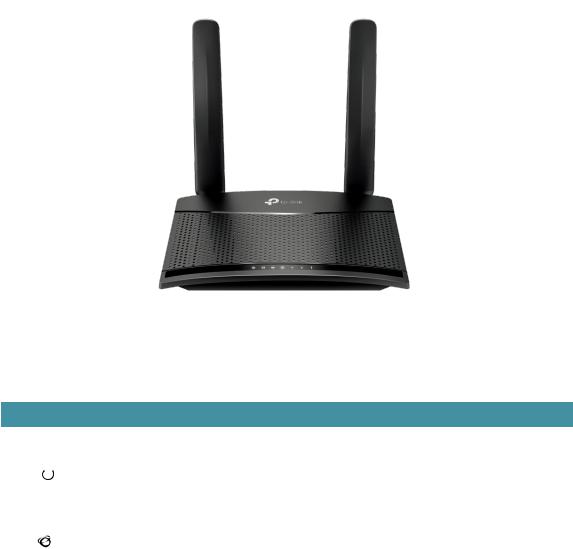
Chapter 1 |
Get to Know Your 4G LTE Router |
1. 1. Product Overview
The 4G LTE Router shares the latest generation 4G LTE network with multiple Wi-Fi devices, anywhere you want.
With Ethernet ports and antennas, the router provides wired and wireless access for multiple computers and mobile devices.
With various features and functions, the router is the perfect hub of your home or business network.
1. 2. Panel Layout
1. 2. 1. Top View
The router’s LEDs (view from left to right) are located on the front panel. You can check the router’s working status by following the LED Explanation table.
LED Explanation
|
Name |
Status |
Indication |
|
|
On |
The system has started up successfully. |
|
(Power) |
Flashing |
The system is starting up or firmware is being upgraded. Do not |
|
|||
|
disconnect or power off the router. |
||
|
|
Off |
Power is off. |
|
(Internet) |
On |
Internet service is available. |
|
Off |
Internet service is not available. |
|
|
|
3
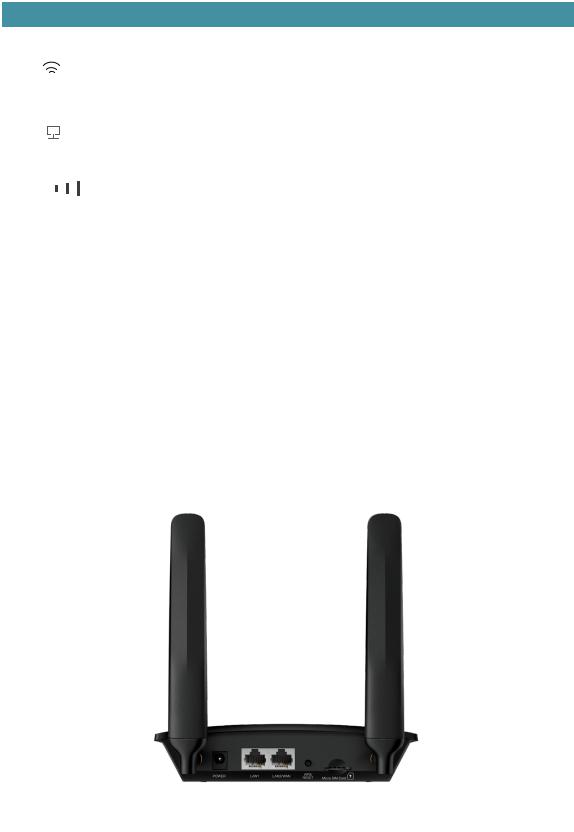
Chapter 1 |
|
Get to Know Your 4G LTE Router |
|
|
|
|
|
Name |
Status |
Indication |
|
|
On |
The wireless function is enabled. |
|
(Wi-Fi) |
Flashing |
WPS connection is in progress. This may take up to 2 minutes. |
|
|
Off |
The wireless function is disabled. |
|
|
On |
At least one LAN port is connected to a powered-on device. |
|
(LAN) |
Off |
No LAN port is connected to a powered-on device or the LAN port is |
|
|
not connected properly. |
||
|
|
||
|
On |
Indicates the signal strength the router received from the mobile |
|
(Signal Strength) |
internet. More lit bars indicate a better signal strength. |
||
Off |
There is no mobile internet signal. |
||
|
 Note:
Note:
1.If the Internet LED is off, please check your internet connection first. Refer to Connect Your 4G LTE Router for more information about how to make internet connection correctly. If you have already made a right connection, please contact your ISP to make sure your internet service is available now.
2.If the Signal Strength LED is off, please check your Internet LED first. If your Internet LED is also off, please refer to Note 1. If your Internet LED is on, please relocate the router to a location where it can receive a strong mobile internet signal, such as near a window.
1. 2. 2. The Back Panel
The following parts (view from left to right) are located on the rear panel.
4

Chapter 1 |
Get to Know Your 4G LTE Router |
|
|
Item |
Description |
POWER Port |
For connecting the router to power socket via the provided power adapter. |
LAN1, LAN2/WAN |
For connecting to your PCs or other Ethernet network devices. |
In wireless router mode, the LAN4/WAN port is used for connecting to a Cable/FTTH/ |
|
|
VDSL/ADSL device. |
|
Press and hold this button until the Power LED starts flashing to reset the router to its |
WPS/RESET |
factory default settings. |
To enable the WPS function, press this button about 2 seconds. If you have a WPS- |
|
|
supported device, you can press this button to quickly establish connection between the |
|
router and the client device. |
Micro SIM Card Slot |
For holding the micro SIM card. |
Antennas |
Used for data sessions over LTE. Upright them for the best mobile internet signal. |
5

Chapter 2
Connect the Hardware
This chapter contains the following sections:
•Position Your 4G LTE Router
•Connect Your 4G LTE Router
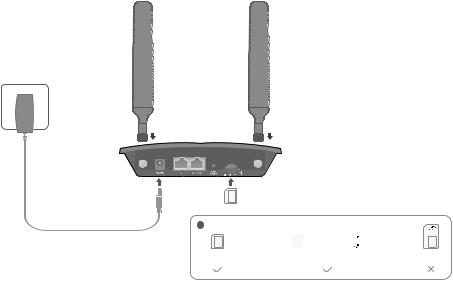
Chapter 2 |
Connect the Hardware |
2. 1. Position Your 4G LTE Router
With the router, you can access your network from anywhere within the wireless network coverage. However, the wireless signal strength and coverage varies depending on the actual environment where your router is in. Many obstacles may limit the range of the wireless signal, for example, concrete structures, thickness and number of walls.
For your security and best Wi-Fi performance, please:
•Do not locate the router in the place where it will be exposed to moisture or excessive heat.
•Keep away from strong electromagnetic radiation source and electromagneticsensitive devices.
•Place the router in a location where it can be connected to the various devices as well as to a power source.
•Place the router in a location where it can receive a strong mobile internet signal.
•Make sure the cables and power cord are safely placed out of the way so they do not create a tripping hazard.
 Tips: The router can be placed on a shelf or desktop.
Tips: The router can be placed on a shelf or desktop.
2. 2. Connect Your 4G LTE Router
Follow the steps below to connect your router.
1.Install the antennas and position them upwards.
2.Insert the Micro SIM card into the slot until you hear a click.
3.Connect the power adapter. The power source shall be near the device and shall be easily accessible.
Power adapter
c.Connect the power adapter to the router.
a.Install the antennas and position them upwards.
Router
b. Insert the Micro SIM card into the slot until you hear a click.
! SIM card requirement
 +
+  +
+ 
Micro SIM card |
Nano SIM card + Provided SIM card adapter + Provided sticker |
Standard |
|
SIM card |
|||
|
|
7

Chapter 2 |
Connect the Hardware |
4. Connect your computer to the router.
Method 1: Wired
Connect your computer’s Ethernet port to the LAN port on the router via an Ethernet cable.
Method 2: Wirelessly
Use the default SSID (Wireless Network Name) and Wireless Password printed on the product label of the router to connect wirelessly.
Method 3: Use the WPS button
Wireless devices that support WPS, including Android phones, tablets, most USB network cards, can be connected to your router through this method. (WPS is not supported by iOS devices.)
 Note:
Note:
The WPS function cannot be configured if the wireless function of the router is disabled. Also, the WPS function will be disabled if your wireless encryption is WEP. Please make sure the wireless function is enabled and is configured with the appropriate encryption before configuring the WPS.
1 ) |
Tap the WPS icon on the device’s screen. |
2 ) |
Immediately press the WPS button on your router. |
3 ) |
The WPS LED flashes for about 2 minutes during the WPS process. |
4 ) |
When the WPS LED is on, the client device has successfully connected to the |
|
router. |
4 




WLAN
On
TP-Link_Home
My Home
My Network
Home Netw
TP-Link_Ne
TP-Link_Test
8

Chapter 3
Log In to Your 4G LTE Router
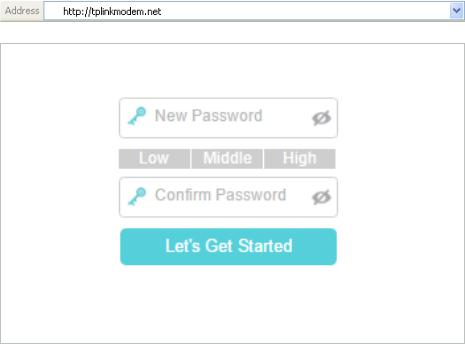
Chapter 3 |
Log In to Your 4G LTE Router |
With a web management page, it is easy to configure and manage the 4G LTE Router. The web management page can be used on any Windows, Macintosh or UNIX OS with a Web browser, such as Microsoft Internet Explorer, Mozilla Firefox or Apple Safari.
Follow the steps below to log in to your router.
1.If the TCP/IP Protocol on your computer is set to the static (fixed) IP address, you need to change its settings to obtain an IP address automatically. Refer to FAQ to configure your computer.
2.Launch a web browser and type in http://tplinkmodem.net or http://192.168.1.1. Set a strong password using 1-32 characters and click Let’s Get Started.
 Note: For subsequent logins, use your password that you have created.
Note: For subsequent logins, use your password that you have created.
10

Chapter 4
Set Up Internet
Connections
This chapter introduces how to connect your router to the internet. The router is equipped with a web-based Quick Setup wizard. It has many ISP information built in, automates many of the steps and verifies that those steps have been successfully completed. Furthermore, you can set up IPv6 connection if your ISP provides IPv6 service.
This chapter includes the following sections:
•Use Quick Setup Wizard
•Create a Connection Profile
•Test Internet Connectivity
•Wireless Router Mode

Chapter 4 |
Set Up Internet Connections |
4. 1. Use Quick Setup Wizard
To set up your router with several easy steps quickly:
1.Visit http://tplinkmodem.net, and log in with the password you set for the router.
2.Click Quick Setup, after configuring your time zone, confirm the parameters with the information provided by your ISP in the SIM part and click Next.
 Note:
Note:
Quick Setup is not available if your SIM card is locked. Unlock your SIM card according to the prompt.
3. Follow the on-screen instructions to complete the setup.
 Note:
Note:
During the quick setup process, you can change the preset wireless network name (SSID) and wireless password. Once done, all your wireless devices must use the new SSID and password to connect to the router.
4. 2. Create a Connection Profile
If your ISP settings are not detected by the router, you can create an internet connection profile by following the steps below:
1.Visit http://tplinkmodem.net, and log in with the password you set for the router.
2.Go to Advanced > Network > Internet page.
12
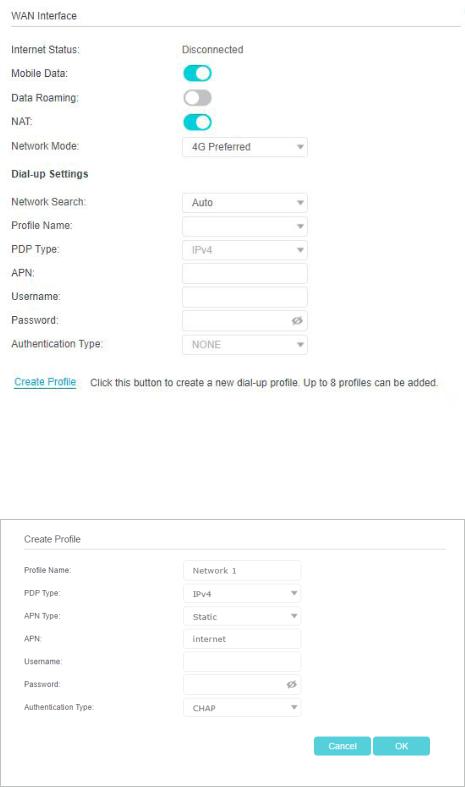
Chapter 4 |
Set Up Internet Connections |
||
|
|
|
|
|
|
|
|
3.Click Create Profile.
4.Specify the Profile Name, Username and Password. Select the PDP Type, APN Type and Authentication Type according to your ISP.
5.Click OK to make the settings effective and the new profile will be used to set up a new connection.
13

Chapter 4 |
Set Up Internet Connections |
 Tips:
Tips:
1.You can view all internet connections or edit connections that are set up manually on this page.
2.You can change the Network Mode to 4G Only or 3G Only according to your needs.
4. 3. Test Internet Connectivity
Aftermanuallysetuptheinternetconnection,youneedtoknowtheinternetconnectivity. The router provides a diagnostic tool to help you locate the malfunction.
1.Visit http://tplinkmodem.net, and log in with the password you set for the router.
2.Go to Advanced > System Tools > Diagnostics page.
3.Click Start to test the internet connectivity and you will see the test result in the gray box.
4.4. Wireless Router Mode
The router support two operation modes, 3G/4G Router Mode and Wireless Router mode. If you already have a modem or your internet comes via an Ethernet cable from the wall, you can set up the router as a regular wireless router to share the internet.
1.Connect your router’s LAN2/WAN port to the modem or the network port.
2.Visit http://tplinkmodem.net, and log in with password you set for the router.
3.Go to Advanced > Operation Mode page.
14
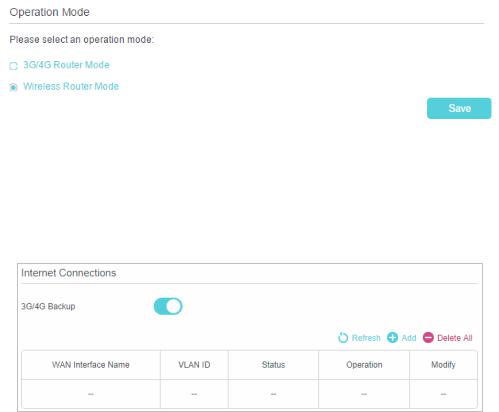
Chapter 4 |
Set Up Internet Connections |
||
|
|
|
|
|
|
|
|
4. Select the Wireless Router Mode option and click Save to make the settings effective.
 Note:
Note:
In wireless router mode, you can use 3G/4G network as a backup solution for internet access. When 3G/4G Backup is enabled, your router will be directly connected to the 3G/4G network when the original network service fails. To enable or disable 3G/4G Backup, go to Advanced > Network > Internet.
15

Chapter 5
Network Security
This chapter guides you on how to protect your home network from cyber attacks and unauthorized users by implementing these four network security functions. You can protect your home network through the SPI firewall, or prevent certain users from accessing the specified service, even block Internet access completely by using Service Filtering. You can also block or allow specific client devices to access your network using Access Control, or you can prevent ARP spoofing and ARP attacks using IP & MAC Binding.
•Protect the Network from Cyber Attacks
•Service Filtering
•Access Control
•IP & MAC Binding

Chapter 5 |
Network Security |
5. 1. Protect the Network from Cyber Attacks
The SPI Firewall can prevent cyber attacks and validate the traffic that is passing through the router based on the protocol. This function is enabled by default, and it’s recommended to keep the default settings.
Follow the steps below to configure Firewall.
1.Visit http:///tplinkmodem.net, and log in with the password you set for the router.
2.Go to Advanced > Security > Firewall.
3.Enable IPv4 SPI Firewall.
5. 2. Service Filtering
With Service Filtering, you can prevent certain users from accessing the specified service, even block internet access completely.
1.Visit http://tplinkmodem.net, and log in with the password you set for the router.
2.Go to Advanced > Security > Service Filtering and enable Service Filtering.
3. Click Add.
17
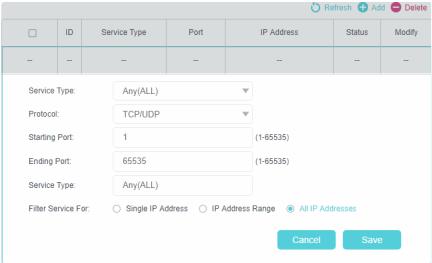
Chapter 5 |
Network Security |
|
|
|
|
|
|
|
4.Select a service type from the drop-down list and the following four fields will be auto-populated. Select Custom when your desired service type is not listed, and enter the information manually.
5.Specify the IP address(es) that this filtering rule will apply to.
6.Click Save.
5. 3. Access Control
Access Control is used to block or allow specific client devices to access your network (via wired or wireless) based on a list of blocked devices (Blacklist) or a list of allowed devices (Whitelist).
I want to:
Block or allow specific client devices to access my network (via wired or wireless).
How can I do that?
1.Visit http://tplinkmodem.net, and log in with the password you set for the router.
2.Go to Advanced > Security > Access Control and enable Access Control.
18

Chapter 5 |
Network Security |
|
|
|
|
|
|
|
3.Select the access mode to either block (recommended) or allow the device(s) in the list.
To block specific device(s)
1 ) Select Blacklist and click Save.
2 ) Select the device(s) to be blocked in the Online Devices table.
3 ) Click Block above the Online Devices table. The selected devices will be added to Devices in Blacklist automatically.
To allow specific device(s)
1 ) Select Whitelist and click Save.
2 ) Click Add.
19

Chapter 5 |
Network Security |
3 ) Click Scan and select the device that you want to add in the whitelist, then the Device Name and MAC Address will be automatically filled in. Or enter the Device Name and MAC Address manually.
4 ) Click Save.
Done!
Now you can block or allow specific client devices to access your network (via wired or wireless) using the Blacklist or Whitelist.
5. 4. IP & MAC Binding
IP & MAC Binding, namely, ARP (Address Resolution Protocol) Binding, is used to bind network device’s IP address to its MAC address. This will prevent ARP spoofing and other ARP attacks by denying network access to a device with matching IP address in the Binding list, but unrecognized MAC address.
I want to:
Prevent ARP spoofing and other ARP attacks.
How can I do that?
1.Visit http://tplinkmodem.net, and log in with the password you set for the router.
2.Go to Advanced > Security > IP & MAC Binding and enable IP & MAC Binding.
3.Bind your device(s) according to your needs.
To bind the connected device(s)
1 ) Select the device(s) to be bound in the ARP List. 2 ) Click Bind to add to the Binding List.
20

Chapter 5 |
Network Security |
To bind the unconnected device
1 ) Click Add.
2 ) Enter the MAC Address and IP Address that you want to bind. 3 ) Select the checkbox to enable the entry and click Save.
Done!
Now you don’t need to worry about ARP spoofing and other ARP attacks.
21
